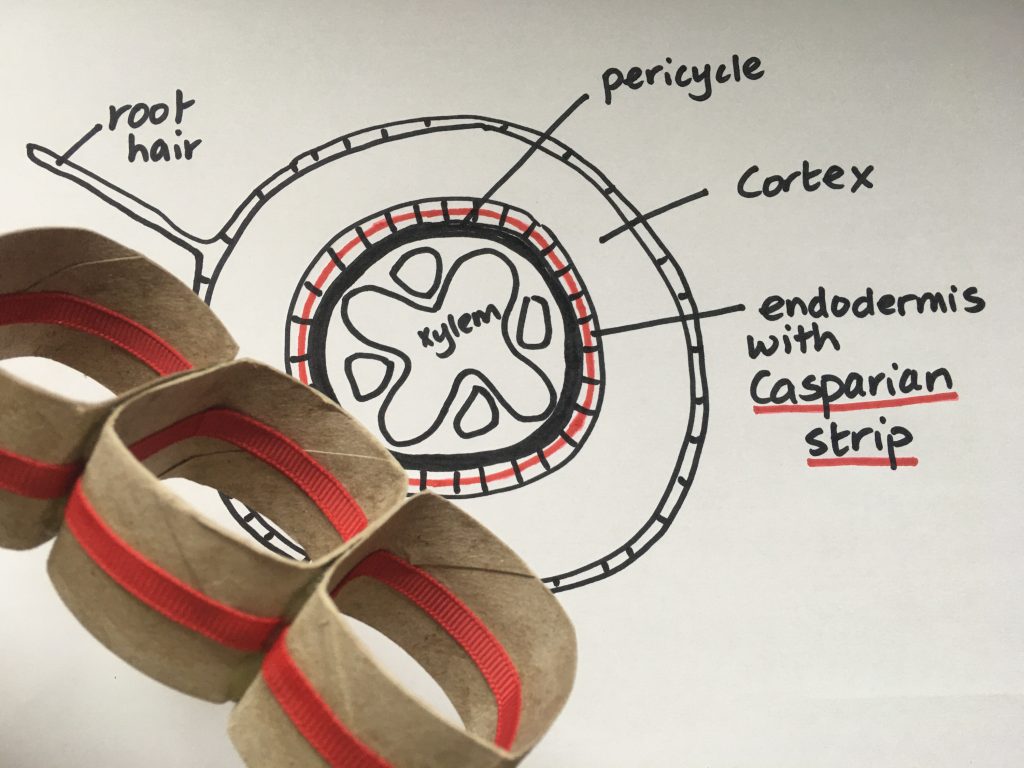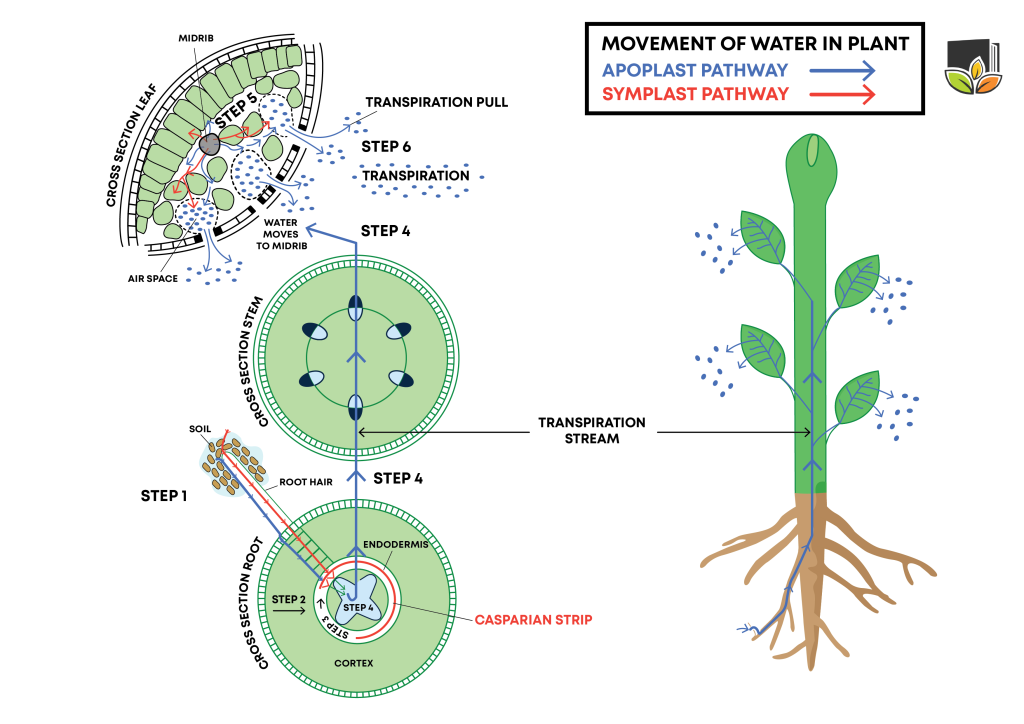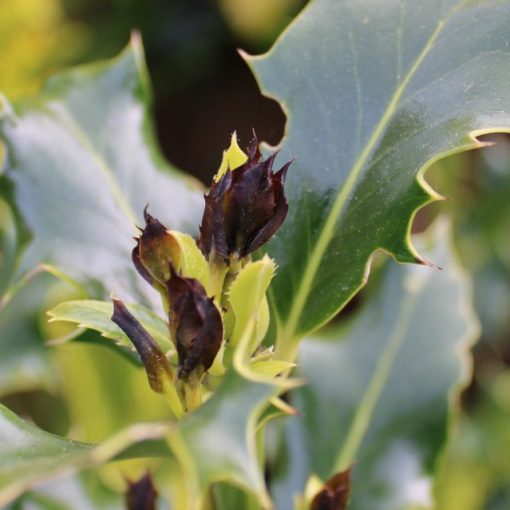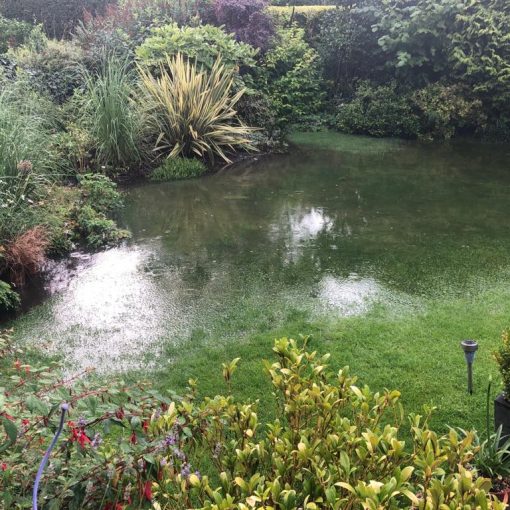R2101 4.3 The movement of water in the plant (old syllabus)
Unit 1 Topic 1 Element 7 (New syllabus)
Introduction
This is not a little topic to study because it ties together the anatomy of the root, stem and leaf and a cell, so you need to be familiar with these cross sectional diagrams before starting to study the detail of water movement. It is also helpful to review photosynthesis. In the syllabus it states that you DO require a diagram of the pathway of water.
You will see that I have mentioned the apoplast and symplast pathway for water movement across cells and this may seem rather complicated for level 2 study – they are not included in the syllabus so do you need to learn them? I am not sure but I do think it is useful in understanding the two different ways water travels across cells ie osmosis and diffusion.
Please note where I say xylem tissue this means xylem vessels and tracheids.
What is the role of water in the plant?
- ‘Plump’ cells which is called turgor pressure hold the plant erect by inflating cells.
- Water is an ingredient for photosynthesis.
- Water is a solvent for nutrients and products of photosynthesis
- Water transports hormones and regulates growth
- In fleshy fruits water assists seed dispersal
- Water cools the leaves as it evaporates (Like us as we sweat)
- Water allows storage of waste products in the vacuole in solution.
What processes are involved when water moves through the plant?
Diffusion, Osmosis, Transpiration and Root Pressure.
Diffusion
This is the movement of a substance from an area of high concentration to an area of low concentration (Down the concentration gradient) which continues until the substance is evenly distributed. This process occurs naturally and does not require energy. Think about how a stink bomb permeates a room or better still, a scented candleDiffusion can happen in air and liquid.
Gaseous diffusion will have been studied when looking at the process of photosynthesis – For example CO2 moving into leaves via stomata and oxygen moving out of leaf via stomata by diffusion.
Water diffusion
In the root water will diffuse from the soil water through the cell walls of the root hairs and across the cell walls of the cortex as long as there is a favourable concentration gradient (High water content towards the outside of the plant root and low concentration of water towards the inside of the root)
Movement of water by diffusion across the root and leaf has a special term – it is called the apoplast route. there is a diagram later.
Osmosis
Osmosis is the movement of water from an area of high concentration to an area of low concentration across a semi- permeable membrane.
In plant cells this semi permeable membrane is the plasma membrane found inside the fully permeable cell wall of the plant cell.
Osmosis is a specific type of diffusion that only ever involves the movement of water. It does not require energy. In the root, water will travel across the cell membrane (which is semi permeable) as long as there is a favourable concentration gradient into the cytoplasm of the cell.
Movement of water by osmosis across the root and leaf has a special term – it is called the symplast route.
Transpiration
This is the loss of water vapour from the plant into the atmosphere by evaporation, through the stomata of the leaves and across the leaf surface. Evaporation is when a liquid turns into a vapour. Transpiration will also take place across the cuticle of the leaf which is why in some plants that can tolerate drought, the waxy cuticle is thick.
Loss of water by transpiration creates a pulling effect known as the transpiration pull which drags columns of water upwards. If plants did not lose water, they would not be able to take it up which sounds strange doesn’t it!
Physical Properties of water to help understand how water moves in the plant
This detail is not needed for the exam. Think of a dew drop or a pond skater on the surface of the pond or the meniscus in a glass of water. You can observe that the molecules of water ‘stick’ together as each molecule has positive and negative charges so are attracted to each other just like a magnet. This is cohesion of water molecules.
These adhesive forces also mean that as well as water molecules sticking to each other they also stick to other surfaces. This so called cohesion tension of water means that an unbroken column of water (the transpiration stream) can be pulled up through the xylem vessels as water vapour is lost through the stomata (the transpiration pull) because the water molecules stick together and stick to the inside of the xylem vessels.
Capillarity
This detail is not needed for the exam. This is a phenomenon where water moves up narrow columns (xylem vessels, tracheids or pore spaces in soil) against the force of gravity. It will occur until gravity stops it. It occurs because the cohesion tension between the water molecules sticks them together and the adhesion force between the walls and the water allows the water to climb upwards. If the conducting tubes are thin the water will rise higher compared to wider tubes. Therefore, it will rise higher in tracheids compared to xylem vessels as these are narrower. This is why conifers (gymnosperms) are the tallest trees as they have only tracheids compared to angiosperms that have xylem vessels and tracheids. This is also why clay soils are wetter than sandy soils as the pore spaces which join together are much smaller in a clay soil and thus the ‘tubes’ are narrower.
The Pathway of Water
1. Root hairs absorb water from the soil water by osmosis (symplast route). The water travels across the inside of the root hair cell and moves across the internal structure, the plasma membrane (which is semi-permeable) from the soil water towards the xylem tissue.
Root hairs also absorb water from the soil water by diffusion (apoplast route). The water travels through the cell walls of the root hair and moves across root from the outside inwards. The water travels much quicker compared to the symplast route.
Revision tip: how do you remember which is apoplast and symplast?
Sympast begins with S and osmosis has lots of s’s in it. Osmosis = symplast
Adaptation for water uptake – large surface area of tiny root hairs.


2. Water travels across the root hairs and across the cortex by diffusion and osmosis until it reaches the endodermis of the root. (See diagram above)The endodermis has an impermeable band surrounding the cells called the Casparian strip which prevents water passing through. When water reaches the Casparian strip, all the water is forced to enter the endodermis by the process of osmosis only as it is forced to follow the symplast route.
This allows the plant to regulate which compounds are entering the xylem vessels.
The 3 D model in the picture is the endodermis and Casparian strip shown in the diagram.


3. Root Pressure. There is a build up of water in the cells adjacent to the endodermis as the flow of water is slowed due to the impermeable Casparian strip. This build up of root pressure gives the water column a ‘push’ upwards. This is demonstrated in rising sap in Spring before leaves emerge and there is no transpiration pull. If you cut a stem low down, water continues to exude.
4. Water passes into the xylem tissue of the root and stems.
Water travels up through the roots and stems in unbroken columns of water called the transpiration stream. The water is dragged up by the transpiration pull. Cohesion tension between water molecules stops the column dropping downwards with gravity. Capillarity and the adhesion force between the water and the inner surface of the vessels helps the column of water to rise also.
5. Water is transported into the xylem tissue of the veins in the leaf and then osmosis occurs across the leaf cells and diffusion occurs across the leaf cell walls. (apoplast and symplast route) towards the air spaces in the lower area of the leaf, next to the stomata.
6. Evaporation then occurs into the spongy mesophyll air spaces within the leaf as the liquid water diffuses into the air spaces as water vapour.
Air spaces in leaf become saturated with water vapour. (High concentration of water)
8. If the stomata are open (Guard cells are turgid and bending outwards to open the pore) water evaporates from the air spaces within the leaf to the external atmosphere. (Diffusion of water vapour from an area of high to an area of low concentration) This is transpiration. The pulling effect is called the transpiration pull.
Water only moves upwards in the plant.
9. The concentration of water in the open air is (usually) lower than within the leaf air spaces so transpiration occurs through the stomata to the external atmosphere.
The difference in the concentration of water within and outside the leaf is called the concentration gradient. The steeper the gradient the faster the rate of transpiration. So for example if we consider plants which are growing on a windy site on a hot Summer’s day the rate of transpiration is high because the concentration of water outside the plant is low as the wind is constantly taking the water molecules away so water is lost more quickly. Also when temperatures are high the rate of transpiration is high.
Detailed Diagram of pathway of water. This diagram explains the outline above.


Relating theory to practice
So you have learnt all this theory – how do we relate all this to practical applications? Here are just a few examples to relate theory to gardening practice.
Fertiliser application rates
Do not over apply liquid fertilisers to the soil. This will increase the concentration of solutes in the soil water and so decrease the concentration of water molecules. This means that water could flow in the opposite direction from the root hairs to the soil water as the concentration gradient has changed, which would seriously damage the plant’s health.
High temperature in the greenhouse
The rate of transpiration increases as temperature increases. Using shade paint or a cooling fan or opening all vents and doors will lower the temperature and so lower the rate of water loss. Also in a greenhouse, because it is an enclosed environment, damping down will help as this raises the relative humidity outside the leaves so the rate of transpiration slows.
Cut Flowers
When stems are cut and not put into water immediately the column of water will continue to move upwards but there is no water to pull up at the bottom. This may result in an air bubble in the xylem tissue so it helps to place cut flowers in water immediately or cut the stem at the base again before plunging in water. Keeping cut flowers in a cool place also slows the rate of water loss due to transpiration, so they will last longer.
First year of a newly planted plant
When establishing new plants, the first year of care is critical. This is because wilting and subsequent death may occur due to lack of water being absorbed by roots. Young plants grown in containers have a limited root hair surface area and so may not be able to survive in their first hot Summer when the rate of transpiration is high. This is why it is often better to plant in the Autumn so the roots can get established before the plant’s first Summer season. If planted in Spring young plants should be watered more frequently than established plants.
Windbreaks
Windbreaks will reduce the rate of transpiration as the relative humidity outside the leaf will be higher and so reduce the amount of water lost to the atmosphere by transpiration. Windbreaks are very important for maximising yield on vegetable plots and orchards.
Further study
http://www.saps.org.uk/animations/plant_biology/index.html?video=1
excellent video summarising water movement and all the plant parts.






